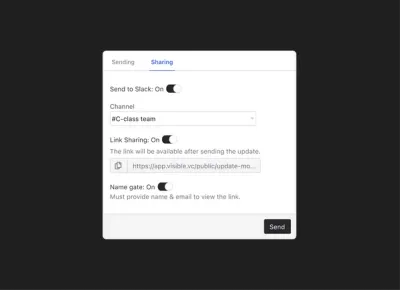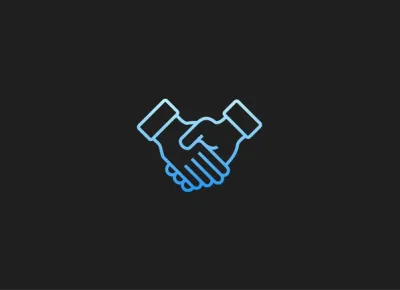Blog
Visible Blog
Resources to support ambitious founders and the investors who back them.
All
Fundraising Metrics and data Product Updates Operations Hiring & Talent Reporting Customer Stories

founders
Reporting
You Missed Your Projections. Now What?
It’s no secret that startups are hard. Over the course of building a company it is inevitable that some quarters/months/years will not go as planned. The period of doubt that follows a down month can be a major setback for a startup. Paul Graham calls it “the trough of sorrow“. Ben Horowitz calls it “the struggle“. The good news; just about every founder has been in the same position and there are steps that can be taken to recover from a down period and carry on.
Take a Step Back
While it is easy to panic and make drastic changes after a down period it is vital that you take a step back and evaluate the issue. Jason Lemkin suggests starting by asking if it was a “hard miss” or a “soft miss”. A soft miss can still grow the business but you may have missed a stretch goal (e.g. Revenue grew by 25%, goal was 35%). A hard miss “is a sign something is amiss” (e.g. adding $500k in Q1 but only adding $200k in Q2).
Lemkin suggests making small changes after a soft miss; rally the team, make small improvements, etc. Acknowledge you’ve missed your goal but ultimately you are still growing the business. When sharing the miss with your investors, be sure to be delicate when sharing the info. While it may have felt like a miss internally growing the business X% is still impressive.
Get In Front of The Issue
A “hard miss” sucks but it is not the end of the world. Get analytical, get into the weeds, identify the issue and come up with a plan to move forward. You have employees, customers, investors, etc. leaning on you so it is important to keep an even keel and create a plan everyone can rally behind to keep the company moving in the right direction.
Most importantly, reach out for help if there are issues you can’t handle yourself. Don’t be afraid to share the details with your investors. The worst thing you can do is hide and fail to keep your key stakeholders in the mix. From your investors perspective, it is expected that you will have down periods and are there to help you through “the struggle”.
Focus and Execute
You’ve discovered the issue, you’ve got a game plan, everyone is aware and ready to move forward. Now what? The past quarter is in the books and it is time to focus on what lies ahead. As Ben Horowitz puts it you need to “focus on the road ahead“;
“When they teach you how to drive a racecar, they tell you to focus on the road when you go around a turn. They tell you that because if you focus on the wall, then you will drive straight into the wall. If you focus on how you might fail, then you will fail. Even if you only have one bullet left in the gun and you have to hit the target, focus on the target. You might not hit it, but you definitely won’t hit if you focus on other things.”
Stayed focused on bouncing back and make it a point for your key stakeholders. If revenue is down, chances are you are closer to your zero cash date and need to make sure this is accounted for. It is likely that you will need to re-forecast your cash and financial projections for the year as well. Share the new projections and make everyone aware of where the business stands after your miss. Over communicate if you have to. Make sure you do everything in your power to avoid back-to-back misses.

founders
Operations
Our 6 Favorite Blogs for Growing Your Startup
In the “world of startups” there is endless amounts of content being published every day. It can be a daunting task determining what sources can be trusted. While curating a list of of our favorite content on a weekly basis for our newsletter, we have come across tons of content and wanted to share 6 blogs we have found to be incredibly valuable and reliable. We hope our list can help cancel out the noise and surface resources to help you fundraise, scale, and hire for your startup.
Related resource: 12 Online Startup Communities for Founders
Point Nine Land
Point Nine Capital is an early stage venture capital firm focused on SaaS and online marketplaces based in Berlin. Point Nine writers offer a unique perspective from the “VC” side of things and share many of their thought processes and benchmarks for evaluating investments.
Our favorite posts from Point Nine Land:
Deconstructing VC’s Decision Making Frameworks
The Top 3 Things Investors are Looking for in SaaS Startups
An Early Stage Founders Guide to Working with VCs — 5 Part Series
SaaStr
Led by Jason Lemkin, Co-founder & CEO of EchoSign, SaaStr features daily blog posts from Jason’s (and other SaaStr writers) journey scaling and selling EchoSign. Posts cover everything from leadership lessons to breaking down Customer Lifetime Value.
Our favorite posts from SaaStr:
How to Gracefully Miss a Quarter. And Take the Right Steps Afterwards.
You Need to Know Where You Stand with Your Investors. Your Investor NPS.
Why Lead Velocity Rate (LVR) is the Most Important Metric in SaaS
High Alpha
High Alpha is a Venture Studio based in Indianapolis. The team (and writers) at High Alpha is made up of experienced entrepreneurs, operators, and investors. The High Alpha blog is a great tool box for finding resources to scaling your enterprise software business from $10M to $100M and beyond.
Our favorite posts from High Alpha:
The Art of Storytelling
What Every Startup Employee Should Know About Finance
The (Second) Greatest Sales Deck and Pitch I’ve Ever Seen
Tomasz Tunguz
Tomasz Tunguz is a Partner at Redpoint Ventures. On his personal blog, Tomasz publishes a daily blog post. Often data-driven and more technical the posts are a great way to get the bottom of key questions most startups face on a daily basis.
Our favorite posts from Tomasz Tunguz:
Clarity of Purpose – The Competitive Advantage of Focus
The 10 Most Important Metrics in a Startup’s Financial Statements
Premoney vs. Postmoney – Which is a Better Technique for Negotiating?
Feld Thoughts
Brad Feld, Co-founder of Foundry Group, has been in entrepreneurship and venture capital for 30+ years. In his personal blog, Feld Thoughts, Brad writes a daily post with current happenings in venture capital and shares experiences from his time in the industry.
Our favorite posts from Feld Thoughts:
Hotshot Advice on Raising Venture Capital
The Ideal Financial Reporting Tempo for a VC-Backed Company
Founders – Use Your Down Round to Clean Up Your Cap Table
Both Sides of the Table
Both Sides of the Table is the personal blog of Upfront Venture’s, Mark Suster. The blog focuses on “both sides of the table” as Mark is a 2x founder and investor himself.
Our favorite posts from Both Sides of the Table:
11 Quick Tips to Get More Value Out of Your Board
Getting Your Head in the Game for Fundraising
Why Raising Too Much Money Can Harm Your Startup

founders
Product Updates
Slack Your Updates
Send Investor and Team Updates in Slack
Today we are launching our Slack integration into beta! You’ll be able to publish Visible Updates to any of your Slack channels in addition to other current publishing methods (email, PDF, shareable link).
We’ll show a preview of the Update text and the first chart or image in your Slack channel with a link to view the rest!
Instantly collaborate with your team member and other stakeholders in your Slack channel around any of your Updates.
Looking for some inspiration?
Send your True North Metric to your company wide channel to show progress towards goal with commentary.
Show your #sales channel how you are pacing for the current period.
Visualize your ARR movements to keep the entire company on the same page.
Stay tuned as this is just the beginning for our Slack integration!
Up & to the right,
Mike & The Visible Team

founders
Hiring & Talent
Attracting Talent with Collaboration
“As the success of business ventures become more and more dependent on attracting and retaining talented people, competition for high quality “knowledge workers” increases. Companies who focus on measuring what actually matters and empowering team members through ownership, transparency, growth, and collaboration have a competitive advantage.” – Peter Drucker
Cross-Functional Collaboration
Building cross-functional teams can be a daunting task. According to Harvard Business Review, 75% of cross-functional teams are dysfunctional. HBR points to one of 5 reasons for cross-functional teams failing, “1.) meeting a planned budget; 2.) staying on schedule; 3.) adhering to specifications; 4.) meeting customer expectations; and/or 5.) maintaining alignment with the company’s goals.”
Forming cross-functional collaboration can be as simple as embracing run-ins at the water cooler, 1-on-1s, weekly all-hands, etc. Your first inclination may be to look at this as a meddlesome distraction full of meetings that start 10 minutes late and end with no actionable next steps. In fact, it can be just the opposite if executed properly. When done right, they can elevate your business, product, and attracting talent.
Free Flow of Information
Building a strong team starts with trust. Building trust starts with open and honest communication. A lack of communication can be detrimental to any team. Peter Drucker, “the founder of modern management” goes as far to say, “Balancing change and continuity requires continuous work on information… Nothing disrupts continuity and corrupts relationships more than poor or unreliable information”.
When discussing best practices for creating cross-functional teams and alignment the CBS Moneywatch team says, “The best way to get these vectors aligned is to create a working climate in which mistakes and failures are viewed as learning experiences, not occasions for blame, and where every member feels included “in the loop”.
Alignment with Company Objectives
While it is important to have KPIs and goals for each individual team, it is equally important that these goals are aligned with the company objectives as a whole (see #5 above for why cross-functional teams fail). Employees can easily forget the role their work plays in the company’s overall vision. When teams come together from different units working towards the same goal it quickly builds a sense of clarity and purpose for each role.
Aligning company goals goes back to the “Free Flow of Information”. Managers and executives should be offering consistent feedback to their teams on their impact towards the company objectives. Additionally this can help “act as a reminder” to each employee and their overall impact to the business. In fact, WorkBoard has found that “72% of employees find their performance improves with more feedback”. Whether it be in-person discussions, a weekly KPI review, or a quick email Update, make sure to keep feedback consistent and regular to keep everyone moving in the same direction.
An Example from Intercom
As I’m sure a lot of you would agree, Intercom has built an incredibly strong product. After much trial and error the product team at Intercom recently published a post, “Make Sales & Product Meetings a Win-Win”, breaking down their winning recipe for aligning sales and product, “has elevated the bond between Sales and Product to new heights”.
When running a meeting, their sales team will present any feedback backed by data to the product team. From here, they open up discussion around the data and continue to build out their plans until their next meeting. In fact, Intercom has leveraged collaboration (image above) as one of their main recruiting tools for attracting talent.
Ready to Collaborate?
Attract talent and rally teams around company objectives using Visible. You just need a business email account to get started.

founders
Operations
Storytelling Lessons from Warren Buffett and Jeff Bezos
A psychology professor and director of Resilience Research at the Appalachian Center, Dr. Sherry Hamby says that sharing stories of personal struggles can make you more resilient and other people more empathetic. Business leaders have also learned that sharing company growth stories can build an emotional connection that helps attract and retain customers, talent, and investors.
There is endless content for telling a compelling story to your customers and team. However, we’ve found investors are often left out of the storytelling framework. We set our sites on two business greats that have become synonymous with using investor letters as a powerful storytelling platform; Warren Buffett and Jeff Bezos.
Stay Focused on Your North Star
Apart from the desks made of doors, trendy sunglasses, and HQ2, Jeff Bezos has become identified with his original 1997 shareholder letter. To this day, Amazon still includes a copy of the 1997 shareholder letter with each annual letter. So what sets it apart and makes it arguably the most famous shareholder letter to date?
According to Tomasz Tunguz, Amazon’s competitive advantage started the day their first shareholder letter was published. Jeff has since remained focused on their “North Star”; customer obsession. Bezos has been able to center every annual letter around their “customer obsession” and simply changes the narrative and storyline. In 1997, it started with e-commerce and saving customers time & money,
“Today, online commerce saves customers money and precious time. Tomorrow, through personalization, online commerce will accelerate the very process of discovery. Amazon.com uses the Internet to create real value for its customers and, by doing so, hopes to create an enduring franchise, even in established and large markets.”
Almost 20 years later, when announcing Amazon Web Services had reached $10B in Revenue. Bezos found a way to align the differing brands and bring back to focus their customer obsession:
“They (Amazon.com and AWS) share a distinctive organizational culture that cares deeply about and acts with conviction on a small number of principles. I’m talking about customer obsession rather than competitor obsession, eagerness to invent and pioneer, willingness to fail, the patience to think long-term, and the taking of professional pride in operational excellence. Through that lens, AWS and Amazon retail are very similar indeed.”
As Bezos has said himself, “You can have the best technology, you can have the best business model, but if the storytelling isn’t amazing, it won’t matter. Nobody will watch”. Whether sending investor Updates on a monthly, quarterly, or annual basis find your “clarity of purpose” and use that to build a theme to your company’s story.
Bring Out Humanity and Trust
Not only is he one of the greatest business minds, the Oracle of Omaha is often regarded as one of the greatest storytellers in business. Just like Bezos, Warren Buffett has turned his annual shareholder letters into a platform for fueling investment and interest in their business.
While Buffett most certainly covers all financial housekeeping he has turned Berkshire’s letters into a platform that builds trust and lets investors (and potential investors) into Berkshire’s decision making and culture. Often filled with everyday language, unique stories, and a sense of humor, Buffett has been able to humanize Berkshire and create a sense of trust with investors. The $87B man has even gone as far to call himself “dumb” in his letters, just as one of your friends or co-workers might. Sure, it might be easier to step outside the norm when your company is valued near $500B but it is never too early to start bringing out the “human side” and building a relationship of trust with potential investors.
What’s Your Story?
Engage prospects, customers, investors, employees, and other stakeholders with Visible. You just need a business email account to get started.

founders
Hiring & Talent
How to Better Align Sales and Marketing
As we’ve explored the essential role of sales enablement, one of the consistent themes that has run through each topic is the vital role marketing efforts must play in enabling your sales team to succeed. And since these two departments are responsible for generating interest in your product and earning revenue, the need for seamless alignment is equally important. So how do you ensure every employee stays in the loop? These simple strategies are a great way to start:
Keep your departments close and your leadership closer
If your sales and marketing teams are both onsite, keep them in close proximity. This allows marketing to sit in on calls or help craft customer communication emails without having to move around the office much. The shared space will create greater collaboration and make organizing cross-department meetings easier.
As for your VP of marketing and VP of sales, they should sit close enough together to each other’s deodorant preference. Jason Lemkin notes that strong sales and marketing executives should meet at least twice a week, even if there isn’t a specific agenda or action items that need to be discussed. Face-to-face time for this dynamic duo is too crucial to avoid. And your marketing leadership will be much better equipped to develop strategies to drive demand generation if they are living in a sales environment and witnessing what it takes in the day-to-day hustle to close deals.
Make objectives and results available to each department
It’s impossible to expect marketing and sales to align on goals if each department initiative isn’t clearly stated and easily available for any employee to access. Use collaborative tools and make a habit to review objectives and results regularly in department meetings. Determine specific ways the two departments can work together to assist in each other’s goals. For advanced companies that keep marketing accountable to a revenue commitment, it’ll be even easier to create a process to mobilize everyone toward achieving the bottom line goals.
Create cross-functional objectives
The C-suite needs to shout out the importance of marketing and sales alignment from the rooftops. But paying lip service to its importance won’t be effective if it’s not followed by incentives. Beyond the quarterly goals centered on qualified leads and revenue obtainment, create initiatives that require sales and marketing to coordinate in order to get the job done. This delivers additional motivation and builds stronger communication among the two teams. Content creation lends itself to cross-department collaboration. Sales and marketing can work together to write articles, develop language for pitching and brainstorm on general copy ideas.
Let sales sit it on marketing
Even if marketing serves to enable sales, alignment isn’t a one-way street. Recommending that marketing employees sit in on sales calls is wonderful and important, but carve out time for sales rep to return the favor. Account executives can benefit from attending pitch meetings or marketing planning to see how specific language can be used as a valuable tool to generate interest in the product. Let your reps spend time being creative and they will better understand the job of marketers and use these skills on sales calls. Don’t just rely on marketing to do all the work to make the two departments understand each other.
Beyond these three strategies, an overall effort to create a culture of collaboration in your organization is paramount. Leaders are required to be honest, direct and use the right tools to keep everyone focused on the top goals you need to achieve.

founders
Operations
Use Storytelling to Increase your Price
This post is Part II or II of our storytelling series. You can find our first post, “Connecting Dots to Tell Your Story” here.
The same principles that Pixar uses to craft their hit movies like Finding Nemo and Ratatouille can be applied to your own investor updates and pitch. Awesome right?
I recently attended SaaStr and had the chance to see Jason Katz the Chief Storyteller at Pixar and Peter Arai the CEO & founder of Prezi talk about the 3 Parts of Visual Storytelling.
Part 1 – Takeaway Message
What is the message you want to leave with your audience? For finding Nemo it is faith vs fear, but the same concept can be applied for business.
At Visible we encourage you to lead with your true north KPI followed by a big ask. Afterall, Investor Updates are most valuable for the company. Leverage your stakeholders to help make introduce to ideal customers, provide guidance on your go-to-market strategy or source new candidates. With each update you have the chance to leave your stakeholders with a takeaway message, don’t squander it!
Part 2 – Structure and Visuals
How do you structure the visual elements to enhance your story? This could be through framing, data visualizations and more.
In addition, your story should follow a structure of beginning, middle and end. Combing structure & visuals can have a profound impact on delivery your key takeaway. Bonus points if you use the same comparable metrics for each update.
One of my favorite posts around data visualization is, “Remove the legend to become one”. This chart:
Is actually the same chart as this one with the same underlying data. (Make sure to check out the post to see how to get here!)
Proper visuals can make all of the difference right?
Part 3 – Delivery
The final part of visual storytelling comes down to delivery. With your stakeholder updates you want to get your message across as efficiently and effectively as possible. You shouldn’t create more work for your stakeholders to get your key takeaway message.
This is why we make it so our customers can control the delivery of their updates through being rendered in email, to PDF, web and Slack.
Great so now we know the 3 parts of visual storytelling but what value can that have on my business? Well it turns out…a pretty big one.
I recently saw Stephen Day from Navidar present at an offsite around M&A, specifically around how to get the best price for you company. He broke it down into this brilliant and simple equation:
Price = Value + (Compelling Story + Competitive Process)^Evoking Emotion
To break this down. Value is the fundamental value of your business. This could be a discounted cash flow analysis to find your valuation.
Related resource: Discounted Cash Flow (DCF) Analysis: The Purpose, Formula, and How it Works
However, you can clearly see how your story and ability to evoke emotion can generate a much higher price than your fundamental one.
This doesn’t just apply to valuation. This can be the pricing of your own product or service as well. The best brands are the best storytellers and they typically elicit the highest price.
Craft your own framework and tell your story. Sign up to Visible today to get started.
Up & to the right,
Mike & The Visible Team

founders
Hiring & Talent
Operations
An Update Template to Ensure You Get the Most of Your All-Hands
Weekly All Hands Team Email Template
There is no doubt that All-Hands Meetings can be a powerful tool to drive culture, share accomplishments, and break down company performance. However, as Ray Gillenwater, CEO of SpeakUp, put it:
“Taking time to get the entire company into a live session is an expensive and risky proposition. It says quite a bit about leadership’s attitude. Namely, we value people in this organization enough to invest in:
Keeping everyone informed of major company updates.
Ensuring everyone is emotionally connected to the company’s goals.
Listening to the team’s (preferably unfiltered) feedback and questions.”
With that being said, it is vital to formalize your All-Hands process and make sure you are doing everything in your power to make sure you are properly utilizing the entire organization’s time.
Below you will find an Update template intended to share before your next All-Hands in preparation for your meeting or share after to summarize the meeting.
The template is largely based off of Square’s Town Hall meetings and is broken into 3 major categories — The Team, Mission & Goals, and Agenda & Questions.

founders
Operations
Build Relationships with Every Customer Using QBR Updates
In an ideal world every company would be able to host a “Quarterly Business Review” for every customer. In reality, QBRs are generally reserved for your “higher touch clients” (read: top tier), as they should be. With that being said, there are easy steps (outside of an in-person meeting) you can take to nurture your lower contract size customers to build a strong relationship and avoid churn. Who knows? They might even blossom into a “top tier” customer.
We suggest checking out the articles below if you’d like to learn more about QBRs:
The Essential Guide to Quarterly Business Reviews from Gainsight
Eight Tips for Nailing Your Next Quarterly Business Review Presentation from Forbes
Scaling QBRs
Traditionally, QBRs are in-person and bring in the executives from both companies. This is great, and ideal, for large enterprise deals. But when you’re a high growth company sending executives across the country is most likely not feasible. With that being said, a quick quarterly Update on the past, present, and future of your business relationships can be a valuable tool.
More than ever, consumers care about quality, transparency, customer support, convenience, cause and usability. The same is starting to become true in the business world. While it is nice to get buy-in from management, employees have more power and discretion when it comes to choosing their tech stack. By sending quick quarterly reports or Updates, Customer Success Managers and end users can build a strong personal relationship and strengthen ties throughout the organization.
Our QBR Update Template
Below you will find our Update Template to send to your clients on a quarterly basis. The template is broken into 5 separate sections; general health, 90 day highlights, benchmarking, usage, and the future. The template is intended to show your company’s value, start a conversation, and get in front of potential issues.
Keep in mind, this template is not intended to be a “one size fits all”. QBRs are a great way to show the value that your product or offering is adding to their business and are a great chance to add “your own spin”.
If you’d like us to drop the template into your Visible account feel free to shoot us a message to support@visible.vc and we would be happy to do so.

founders
Product Updates
Visible Now Integrates With 1,000 Other Products
We know that getting your work done requires many different web tools. In fact, the average business uses between 10 and 16 apps. You have your email app, CRM, note-taking tool, cloud storage tool, team communication app, along with project management tools and various to-do lists. Sometimes, it can be a struggle to get them all working in tandem. Now that Visible has 1,000 integrations, you can choose your favorite tools and easily integrate them with Visible.
Visible now connects to 1,000 other web tools, thanks to our Zapier integration. With workflow automation tool Zapier, you can set up your own codeless integrations called “Zaps”. Zaps will automatically send information from one tool to another, so you’ll spend less time manually transferring data between your business tools and can dedicate more focus to creative, big picture tasks.
Boost Your Productivity with Popular Visible Integrations
No matter what other apps you use, chances are Visible integrates with them via Zapier. Here are some of the most popular integrations that Visible users already use to be more productive.
The New Year is the perfect time to evaluate your processes and find ways to boost productivity. Check out some of the Visible Zap’s here.

founders
Reporting
Connecting Dots to Tell Your Story
Business Storytelling
Looking for a New Year’s Resolution? Keep reading!
Storytelling in business has become a clear competitive advantage over the past decade. Customers, investors and talent have more choices than ever and are armed with more information than ever. Companies that can effectively tell their story will create emotional engagement with their stakeholders, cut through the noise and ultimately drive growth.
In relation to fundraising, storytelling is a crucial component of driving interest and ultimately term sheets. This is especially true in the early stages as checks are written more on vision than traction.
There are a lot of great resources for storytelling in relation to fundraising so check back for Part II next week for storytelling specifics.
Today I wanted to focus on one often overlooked part of fundraising & storytelling and that is “connecting the dots”. Simply put, how do you create a cadence with potential investors and consistently drip information so that when you are fundraising trust is established and momentum can be created.
As with my things in life, what you invest in is what you’ll get out. Fundraising is no different. Investing in stakeholder relationships early on and putting in the effort will pay dividends down the line. While fundraising is legally a “transaction” it is far from one to actually get there.
(Sidenote: fundraising is a funny thing isn’t it? Investors tell you are fundraising 24/7/365 but they also tell you to tell investors you are not fundraising.)
Seasoned investors won’t invest on their first interaction. They invest in lines & trends. They want as many data points as possible before make a decision. Afterall trends tell a story. Mark Suster penned this perfectly over 7 years ago in, “Invest in Lines, Not Dots”.
“Most importantly tell them what you plan to achieve by the next time you see them. Hopefully by then you’ve made good progress. You’ll be able to give them an update on key hires, pilot customers, key tech innovations — whatever. Keep these interactions low-key and short. Quick coffees, whatever. Swing by their offices to make it easy for them to say yes and promise not to take up more than 30 minutes for the update (and stick to it).”
Your interactions with stakeholders might look like this before you are officially fundraising:
Each one of these dots represents an interaction and the chance to further tell your story. Over time you’ll build the trend and establish a rapport. You’ll be surprised how your entire fundraising process will change for the better. This doesn’t relate to just fundraising. It can be applied to key hires, potential acquirers and other key partners.
Want to put your marketing hat on? Utilize Visible Updates + Lists to drip updates to potential investors in between your in-person interactions. Sign up here!
Want to maximize your round competition and decrease decision marking time? Make sure to check out Part II.
Up & To the right,
Mike & The Visible Team

founders
Product Updates
How and Why We Changed Our Onboarding
Intro
User Onboarding is one of the most challenging aspects of product design. Approaching the task of how can we improve our onboarding experience can end up involving an evaluation of the entire product offering and the messaging around it (including but not restricted to all marketing material, ads & search results in google, your website, and it of course runs right through your product.)
The latest part of our user onboarding experience we recently undertook evaluating was the first run in product experience. This was our third attempt at tackling it. From our research we’ve seen that we’re not alone in the struggle to get this right. A look across the blogs of many other products will show blog posts about onboarding experiences which have since been overhauled completely. It’s clear there is no one perfect onboarding technique and a successfully onboarded user is a difficult thing to measure. From out latest effort however, we’ve seen some exciting results and we’ve got some great feedback and questions so far so we decided to share a little insight into what led us to out current solution.
Just saw your new product update re: the contextual help guide. Great feature! Did you guys build this inhouse or use a tool to develop it?
Just read your blog post on your new help guide–I like the way you tackled that! Did you build that custom or use a product to provide contextual help?
The Problem
Our previous iterations focussed on a very particular and direct path towards what we considered to be an onboarded user within our own product. We established after which actions our users were most likely to become paying customers by looking at the statistics. We tried to then work out the shortest path to that point to create an onboarding experience that would get them to that ‘aha’ moment in one run. We tried two different approaches to this. Both with varying levels of success. It was clear that users were taking more actions within the product, but we weren’t seeing an increase in conversions to paying customers – or certainly nothing we could confidently attribute to our new onboarding experience. If anything, it was actually muddying the stats with regards to actions taken within the product because it was unclear how motivated these actions were, and whether users were seeing real value at the end of it.
We decided to take a step back and to scrap our previous concept of what we considered an onboarded user. We weren’t disregarding those main actions as a primary driver of adoption, but it was clear that the decision to convert didn’t come as easily as completing three steps and handing over the credit card details. The reasons that may cause one user to convert to a paying customer may not be the same for the next user. While their goals will be similar, there are different aspects of our product that can serve to help our users achieve them and the clinching moment for each user can be quite different.
We wanted to create a first run experience that better showcased our product and the things it can do, rather than getting our users to fulfil a specific number of actions. We also wanted to find a method that didn’t hinder the overall user experience by forcing the users down paths they may not want to go initially. We wanted to design a less intrusive onboarding experience, but one that still ensured our users didn’t get lost or give up before seeing the value of our product and came away having a very good sense of how Visible could help them achieve their goals.
Our users were converting once they’d had a chance to explore Visible, to see it’s wealth of features, it’s simplicity and ease of use and most often, for how quickly they could create data rich, beautiful updates. We were confident we could remove our previous onboarding walkthrough and we could leave users in our product with no help and almost all will figure out the main actions within our product. However, what they might not see in a first run experience is the wealth of other rich features in our product that are deliberately a little less obvious initially. The nature of our product means we have a lot of features, some complex, some simple. We wanted a way to showcase these features and offer direction for future actions, but not insist right off the bat.
The Solution
What we came up with was the Visible Help Guide. The idea was that it would be contextual and show the right information at the right time. It would be unobtrusive and only offer help when help was asked for and get out of the way when it was not needed. It would be adaptive and help each user progress in the direction they wanted to take and not through a set of predefined steps that we had decided for them.
In order for it to be contextual we ensured it was wired up to the relevant sections of our product so that when it was opened, it would first show help content relevant to that specific area of the product. If it was requested at first (we ask them how they’d like to explore Visible at the beginning), it would pop out when a user first visited an area of the product with relevant help and suggestions for that section. It would then also offer a quick overview of everything they could do from within that section and as a result gave an insight into the wealth of features available in Visible without overwhelming or insisting they complete them in a first run.
The result is a clever resource that will grow with our product and acts as a reference for everything that can be done within Visible. It offers guidance to new users to get started and prompts for next actions without insisting, and it also acts as a useful reference for more experienced users to ensure they’re getting the most out of Visible and to uncover some features that they may not have been using previously.
The response has been extremely positive. We’ve seen a 30% increase in Product Qualified leads coming through since we implemented our new guide! (Learn more about PQL’s here). We’re seeing more actions being taken within the product than our previous onboarding experiences and our users are taking these actions themselves. It’s also helped to reduce the number of requests coming into our customer support team for queries on how to perform specific actions as our users can now get help from within the app and also have an easier way to find our knowledge base in Intercom. We’re sure there will be future iterations on what we currently have but the results so far have been very positive and we finally have something to build on.

founders
Fundraising
Reporting
An Update Template from DCG for Blockchain & Digital Currency Companies
Digital Currency Group Monthly Update Template
With the price of Bitcoin surging and digital currencies taking center stage on major news networks many companies in the space are having difficulties separating their growth with industry growth.
Our friends at Digital Currency Group are one of leaders in the digital currency/blockchain space. Their portfolio of companies has accounted for an impressive 70% of industry funding to date.
As the industry continues to grow the team at DCG put together an investor update template for their portfolio companies to use. With the appeal of blockchain/digital currencies at an all time high the template is aimed to allow founders to separate their success from that of the entire industry.
At DCG, as investors and company builders, our skill is our ability to recognize patterns. Without clear data and insight, it’s very difficult for us to guide and support our companies. More importantly, the old adage, “top of mind, tip of tongue” certainly holds true. The more companies share with us, the more we are able to support them, and the more we can tell everyone in our network about the great things they’re building. – Meltem Demirors in “The Next Round: How to Build Growth Stories with Data”
The DCG Template below is broken into 7 sections that give investors the information needed to help companies as much as possible. In addition to the 7 sections DCG offers 3 key points for sharing information with investors and stakeholders:
Keep it simple and short – bullet points are easy to read
Be extremely specific
Include charts where you can
Check out the DCG Template Here >>>

founders
Metrics and data
Pull Levers in your Sales Funnel with Product Qualified Leads
Product Qualified Leads (PQLs) have become a major trend in SaaS companies over the last couple of years. Why the shift to the new framework? I have two thoughts. 1) The way organizations sell and market their products are different and 2) business software continues to look more and more like consumer software.
We’ve scaled Visible to hundreds (soon thousands) of paid customers with a lean team through adopting a Product Qualified Lead framework.
Disclaimer: Product Qualified Leads may not fit into every business and organization as some solutions may require intensive initial implementation or for strategic reasons the end-user never gets to try the product. Typically these are high ACV products.
Regardless of your business, I hope you still get some value from this post and takeaway parts you want to use in your own processes. My goal is to get you walking away thinking how a Product Qualified Lead framework can increase efficiencies cross sales, marketing, customer success and finance, and product.
The “old” way
If you’ve attended any sales or marketing conference, seminars or training sessions you’ve likely heard someone beat the BANT (Budget, Authority, Need, Timing) drum. It is a matrix provided to make sure you are spending your resources on the right leads. It looks something like this:
Paired with the BANT framework is usually the idea of the Demand Generation funnel. It looks something like this usually:
Both of these frameworks work off one another. Typically you’ll have marketing initiatives to drive leads. This might be paid advertising, webinars, downloadable content or having business development representatives (usually called BDR’s or if you are fancy “Solutions Consultants”).
Once you get a download, opt-in, etc you’re likely to consider that person a Marketing Qualified Lead (MQL) where they might be nurtured with a steady drip of content, get contacted by a Inbound BDR to qualify them some more, etc. This is where you are trying to understand the BANT for a lead to see if they should be moved to Sales Qualified Lead (SQL).
Then you might have an Account Executive accept the SQL to do their own qualification, provide a demo and truly understand the lead’s BANT. If the AE accepts the SQL it will likely be converted to an Opportunity, worked and hopefully closed from there.
Now there is nothing wrong with this framework at all. It’s deployed by tens of thousands of companies and for metric/forecasting junkies it provides a great way to measure ROI across all of your activities. However, if you layer a PQL framework into your current you can allocate resources even more effectively across your business in addition to have another growth lever to pull.
What are Product Qualified Leads?
Product Qualified Leads are potential leads using some version of your current product that take some sort of action. Typically this is some sort of trial or freemium experience.
Defining PQLs are ultimately up to you as engagement for every business is different. E.g. Slack’s magic number is 2,000. Slack knows that if they can get you to send 2,000 messages there is a great chance they’ll get you as a customer.
At Visible, our PQL criteria is as follows:
Connected 2 or more data sources
Created 1 chart
Published an Update
Invited a colleague
If you do those actions, there is a 90% chance we will get you as a customer (if not within the trial then within 90 days).
With most frameworks, testing and iterating is crucial here to get you to zero in on your PQL qualifications. E.g. our original PQL definition was just one data source but found our customers value bringing in multiple data streams so wanted our PQLs to reflect that.
Improving Marketing
You likely nurture your leads based on who they are and what they have downloaded. Shouldn’t you do the same with PQLs? What about prospects who are not yet a PQL? Can you effectively drip them helpful content while they are on a trial? The answer is yes to all of the questions.
If you have a definition of your PQL there is no reason why you shouldn’t have dynamic product marketing to go alongside it. E.g. if a lead has taken actions A & C but not B. I’d make sure that your email is geared towards making sure they do B. Whether it is social proof from a customer case study or an AE calling to offer a hand.
Hint: Intercom + Segment is great for this.
Improving Sales
PQLs can help in a lot of areas in your selling organization. The biggest impact (in my opinion) is around where AEs can dedicate their valuable time.
Demo Conversion: According to Tomasz Tunguz, “When the sales team calls PQLs, customers typically convert at about 25 to 30%”.
If you are calling on customers who are already PQLs this is a great way to have a more meaningful conversation. They have already had a chance to use your product, will have specific questions and overall be a much more engaging conversation.
Hubspot and Openview touch on “In Product Hand Raisers” in Why Product Qualified Leads are the Answer to a Failing Freemium Model stating that “Hand-raisers can convert at 2x-4x the conversion rate of traditional MQLs.”
In Mitch Morands’s post, “MQLs are DEAD! Enter the PQL “Product Qualified Lead” = 10X+ revenue impact” he states that PQLs convert 10X+ more revenue than MQLs
I’d argue “Need” and “Timing” are identified in BANT through PQLs. You can quickly see how they are engaging with your solution and typically your trial with have a some sort of end date. How many times have your AEs sat a demo where they prospect said “This is awesome, hit me back in 9 months when we are looking to deploy. I’m just doing some research right now”
Improving Product & Engineering
Getting your team rallied around PQLs will help prioritize the product roadmap, create focus within the product and make sure your onboarding is buttoned up.
Related: Check out our new Contextual Help Guide we just launched to help new trialers get to PQLs faster.
Improving Customer Success & Support
There is a great proverb that relates to customer success and product:
“If you catch someone a fish, you feed them for a day. If you teach them to fish, you feed them for a lifetime”
By focusing on PQLs, we make sure our customers can get in and use the product from when they sign up. If they get stuck we make sure we have a great knowledge base, help resources and more. If they are really stuck, we are always happy to get a quick screen recording or demo setup with a customer.
This has mentality has created less customer support issues which means our median response time is 5 minutes. It also lets our customer success team be proactive to help leads get into a product qualified lead state.
Improving Finance
There is no shortage of ratios that PQLs can help improve. Customer Acquisition Cost, Time to Close, Lifetime Value, Trial to Close %, etc. Focusing on creating PQLs will help all of your metrics become more attractive.
Bottomline
PQLs provide a great way to align everyone in your organization. The product team gets to focus on building a great product, the sales team can spend their team on highly qualified leads and the marketing team can dynamically nurture leads.
Don’t ditch MQLs, SQLs or your current process. Just try segmenting them with PQLs to increase conversions in all parts of your business.
Try it out and track it as a metric in your Visible account 😉
Up and to the Right,
Mike & The Visible Team

founders
Fundraising
An Update Template for Sharing Your Deck with Potential Investors
There is quite a bit of controversy over when and how to send your pitch deck to potential investors. Some investors will tell you to send the pitch deck as soon as possible, others will say send a teaser deck, and some will say wait until you have a meeting with partners to send your pitch deck. No matter how you decide to send your pitch deck, we’ve laid out a template for sharing your pitch deck for when you’re ready.
Unlock Your Investor Relationships. Try Visible for Free for 14 Days.
Start Your Free Trial